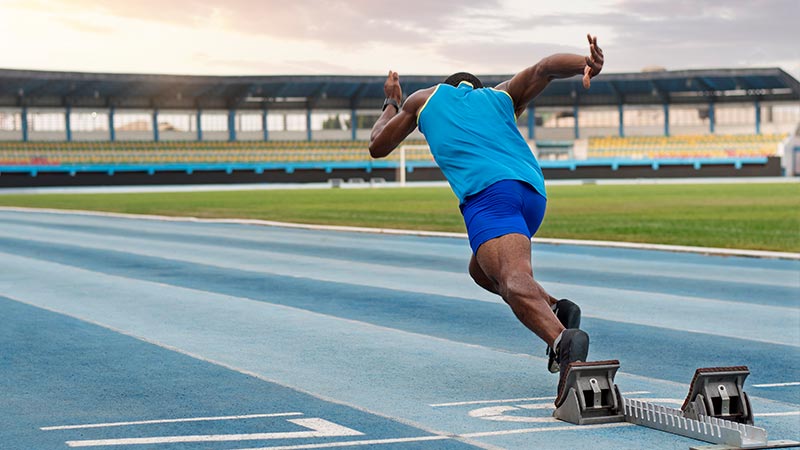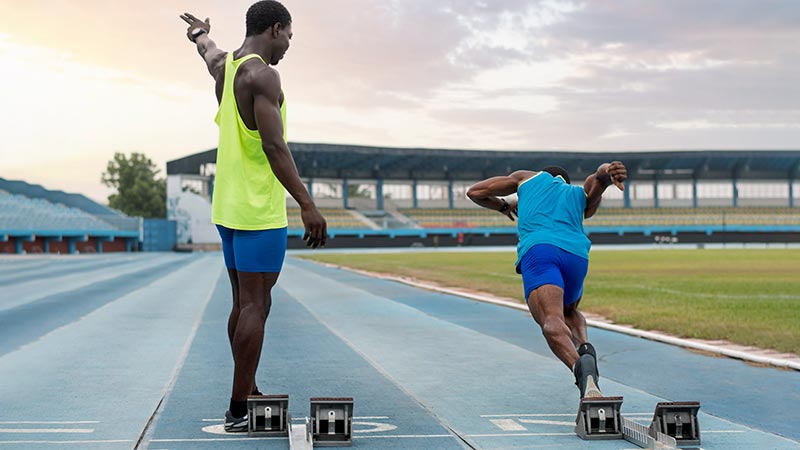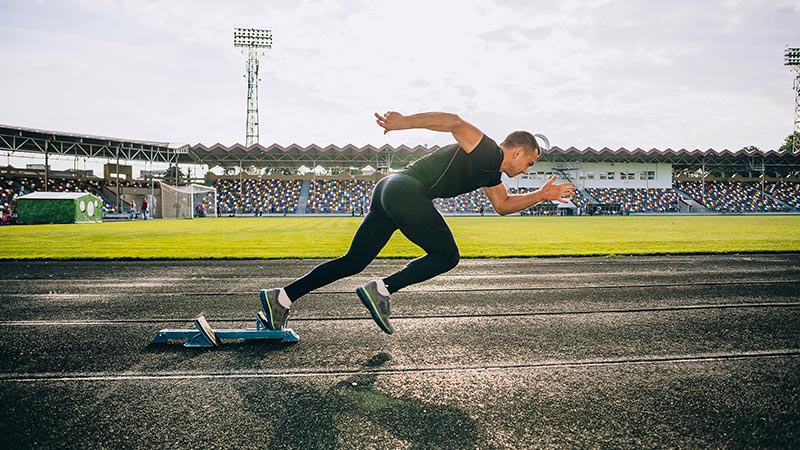Becoming a sprinter isn’t just about the need for speed. It’s also about honing your technique, building physical strength, and developing mental toughness.
Sprinting is an explosive, captivating event in track and field that demands physical prowess and technical finesse.
I’ve always believed anyone passionate about running can become an accomplished sprinter. It’s not merely about possessing natural talent or having lightning-fast reflexes – though those certainly don’t hurt!
What truly sets apart the average Joe from Usain Bolt is a commitment to training hard, learning continuously, and never giving up even when the finish line seems miles away.
So, how can you become a sprinter? The journey begins with understanding what it takes to excel in this demanding sport.
In my experience as a runner and coach, I’ve identified three core aspects: improving speed, enhancing strength and agility, and fostering a resilient mindset. Let’s explore each of these in more detail.
Understanding the Basics of Sprinting

It’s a form of speed running that requires maximum effort over short distances, usually not exceeding 400 meters. We can break down this powerhouse sport into three phases: acceleration, maintaining top speed, and deceleration.
Firstly, we have the acceleration phase. When I leave the blocks, I employ every muscle to propel myself forward with as much force as possible. This initial burst sets winning sprinters apart from the rest of the pack.
Next up is maintaining top speed – easier said than done! The ability to sustain your fastest pace without slowing down or tiring comes down to fitness level and technique.
As a sprinter, it took me years of rigorous training to perfect my stride length and frequency for optimal performance.
Finally, deceleration is an often overlooked but vital part of any sprint race. Any experienced runner knows that managing energy reserves throughout the race is crucial so you don’t burn out before crossing the finish line.
To give you some perspective on just how fast elite sprinters are:
| Athlete | Time (100m) |
|---|---|
| Usain Bolt | 9.58 sec |
| Tyson Gay | 9.69 sec |
These record-setting times highlight not only their extraordinary physical capabilities but also their flawless execution of each phase.
Sprinting isn’t just about raw power and speed, though; it’s also highly technical:
- The angle at which you explode off those blocks
- Your leg drive during acceleration
- Maintaining proper body alignment while running at full tilt
All these factors play substantial roles in shaving precious milliseconds of your time.
As we delve deeper into this journey towards becoming a proficient sprinter, remember that mastering these basics will pave your way for success on the track.
Training Techniques for Aspiring Sprinters

Training techniques for aspiring sprinters encompass a multifaceted approach to enhance speed, power, endurance, and overall athleticism.
Here’s a comprehensive breakdown of effective training strategies:
Sprinting Mechanics
Proper form is fundamental for maximizing sprinting performance. Athletes should focus on maintaining relaxation throughout the body, particularly in the shoulders and hands.
Short, rapid strides are preferred over long, bounding ones, promoting faster turnover. Additionally, synchronized arm movement is crucial for generating momentum and balance.
Strength Training
Building lower body strength is essential for generating explosive power during sprints. Exercises like squats, lunges, deadlifts, and calf raises target key muscle groups, including quadriceps, hamstrings, glutes, and calves.
Incorporating plyometric drills such as box jumps, explosive lunges, and hurdle hops can further enhance explosive strength and speed.
Core Stability
A strong core is vital for maintaining proper posture, balance, and stability while sprinting. Core exercises like planks, Russian twists, leg raises, and medicine ball rotations help develop abdominal, oblique, and lower back muscles, improving overall body control and reducing the risk of injury.
Cardiovascular Conditioning
Sprinters require both anaerobic and aerobic fitness to sustain high-intensity efforts and recover quickly between sprints.
Interval training, alternating between short bursts of maximal effort and brief rest periods, improves cardiovascular endurance and lactate threshold.
Cross-training activities like cycling, swimming, and rowing can complement sprint training while minimizing repetitive joint stress.
Flexibility and Mobility
Flexibility training is crucial in preventing injuries and optimizing performance by enhancing muscle elasticity and joint range of motion.
Dynamic stretches like leg swings, arm circles, and high knees should be performed before workouts to increase blood flow and loosen up muscles.
Post-workout static stretches targeting major muscle groups aid muscle recovery and promote long-term flexibility.
Technique Drills and Sprint Variations
Incorporating technique drills and sprint variations into training sessions can help refine sprinting mechanics, improve acceleration, and enhance top-end speed.
Drills such as high knees, butt kicks, A-skips, and B-skips focus on proper foot strikes, knee drive, and arm action.
Sprint variations like hill sprints, resisted sprints (using sleds or resistance bands), and overspeed training (downhill sprints or assisted towing) challenge athletes to adapt to different running conditions and stimuli, ultimately leading to more excellent speed development.
Rest and Recovery
Adequate rest and recovery allow muscles to repair and adapt to training stimuli. Sprinters should prioritize sufficient sleep, hydration, and nutrition to support optimal performance and minimize the risk of overtraining.
Active recovery techniques such as foam rolling, massage, and light stretching can alleviate muscle soreness and enhance recovery between intense training sessions.
Incorporating Nutrition in Your Sprinting Journey

Embarking on a sprinting journey? You’ll want to take your nutrition seriously. It’s not just about running faster and longer; it’s also about fueling your body with the proper nutrients.
Like other athletes, Sprinters need a balanced diet high in carbohydrates, moderate in protein, and low in fat.
Carbohydrates are your body’s primary energy source for intense activities like sprinting. They’re stored as glycogen in muscles and liver and converted into glucose (energy) during exercise.
Here’s an example of what a typical meal plan might look like for an aspiring sprinter:
- Breakfast: Oatmeal with fruits, nuts, and a scoop of protein powder.
- Lunch: Chicken breast or tofu with brown rice or quinoa and plenty of colorful veggies.
- Snacks: Yogurt with berries, banana with almond butter, or a homemade energy bar.
- Dinner: Grilled salmon or chickpea curry served with sweet potatoes and steamed broccoli.
Staying hydrated is equally important. Dehydration can lead to decreased performance and increase your risk of injury. Aim to drink at least 2 liters (about 8 cups) of water daily – more if you’re training hard or it’s hot outside.
Supplements can also play a role in enhancing performance. However, I’d recommend consulting a sports nutritionist before starting any supplement regimen.
Some commonly used supplements by sprinters include creatine monohydrate for increased power output and whey protein for muscle recovery.
Remember that everyone is different – what works well for one person may not work well for another. Keep experimenting until you find what feels best for you!
Conclusion: Embracing the Sprinter’s Lifestyle
Becoming a sprinter isn’t just about physical training. It’s also about embracing a particular lifestyle. A lifestyle that prioritizes health, discipline, perseverance, and mental toughness.
First off, let’s talk about diet. I’ve learned that eating right plays a huge role in my performance on the track.
High-quality proteins for muscle recovery, complex carbohydrates for energy, and plenty of fruits and vegetables for vitamins and minerals should make up most of your meals. And don’t forget hydration. Drinking enough water each day is vital.
Next up is rest. Proper sleep is non-negotiable if you want to perform at your best as a sprinter. Your body needs time to heal and recover from intense training sessions.
Then there’s mental toughness. Trust me when I say this – sprinting can be as much a mental game as a physical one! You must develop resilience and determination to push through tough workouts or bounce back from disappointing performances.
Lastly, remember that consistency is critical in this sport. Whether sticking with your workout schedule or maintaining healthy habits, consistency will help you reach your goals over time.
Here are some quick tips:
- Keep a record of your training sessions so you can track improvements.
- Listen to your body – if you’re tired or sore, rest a day extra.
- Don’t neglect other aspects of fitness like flexibility and strength training.
- Stay motivated by setting achievable short-term goals along with longer-term ones.
Adopting these changes in your life is not always easy, but believe me when I say it’s worth it! Becoming a successful sprinter may be challenging, but with hard work comes great rewards! So why wait? Lace-up those running shoes and embrace the sprinter’s lifestyle today!







